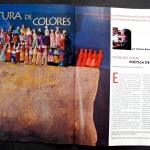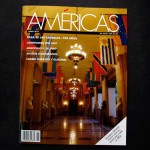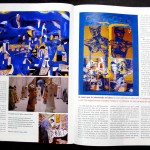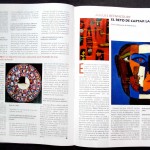Miguel Betancourt en Americas Magazine de la OEA
May 20, 2010
Expressions of Experience: A insight into the vivid range of contemporary art in Ecuador from two native sons–Osvaldo Viteri and Miguel Betancourt.
OSVALDO VITERI
THE POETICS OF MESTIZAJE
Ecuador, land of volcanoes and artists, has in painter Osvaldo Viteri, one of its greatest exponents. The renowned maestro is a multi-faceted and anti-dogmatic artist whose art is a reflection on the identity of the Ecuadoran people and the world view of Latin America’s mestizo culture.
Perhaps it was the memory of his childhood on his grandmother’s farm that took him back to his roots and led him to study his magical land. Or perhaps it was the volcanoes. “El Tungurahua, the fierce and active volcano, grounded me,” Viteri says. “Cotopaxi gave me magic and love, and Pichincha gave me peace, humanity, and awe.”
Viteri’s creative process led him to produce the Ensamblajes series [Assemblages], which marked a turning point for visual arts in Ecuador, and in all of Latin America, with an artistic conceptualization of the topic of mestizaje, or mixed cultures.
The 1950s, 60s, and 70s were significant decades for Ecuador as its economic and industrial progress gave it a more prominent place on the international stage. Artists participated in this change, following the vanguard artists of Europe and the United States. Viteri was part of the transformation and was also the precursor of a new esthetic vision.
Viteri was born in Ambato, in 1931, into an educated family of Basque origin that had come to Ecuador early in the colonial period. Though he studied architecture in college, Viteri knew that his real vocation was in painting and he developed this career through multi-faceted work.
Viteri has had numerous exhibitions in Europe, the United States, and Latin America, and has participated in many international shows in places such as: the General Conference of the International Council of Museums (ICOM) in Argentina; the National Museum of Fine Art in Stockholm, Sweden; the Sainsbury Centre for Visual Arts, at the University of Essex, England; the Palacio Velazquez in Spain; and the Americas Collection Gallery in Miami, among others.
He has won many awards, participated in several international biennials, and lectured in universities in Ecuador and the United States. He has also held a number of teaching positions. Viteri’s works appear in private museums and collections. In 1996, he attended the official presentation of his paintings for the self portraits collection in the Galleria Degli Uffizi in Florence, Italy.
In 2000, the National Museum of Fine Arts in Argentina held a retrospective of his work, and in 2005, when the Museo Provincial de la Casa del Portal was inaugurated in Ambato, two halls were dedicated to Viteri, with 85 paintings donated by the artist.
Viteri’s prolific works have emerged in a number of separate phases: in the 1950s and 60s, he concentrated on symbolic geometry that tended towards expressive abstraction. Drawing and painting coexist in his work as he moves through visual geography with various styles and techniques. In the Serie de desnudos he works in sanguine with free and natural brushstrokes, while in Serie neofigurativa from the 1990s, he prefers ink, which he also uses in the Serie tauromaquias/Quijote (2005). By contrast, he uses colors in Serie Panzaleo and impastos and texture in the Serie de los desastres de las guerras (2000).
In the late 1960s, his Ensamblajes marked a break with the visual art styles of his time and made its mark in art history through a new kind of language where symbols, signs, and concepts merge in a mixed technique of strong chromatism and texture.
Ensamblajes are structures that fall somewhere between painting, sculpture, textile art, and collage. Here, the indigenous and the colonial, the sacred and the profane, high society art and popular art all come together with an intense sense of poetry. Ensamblajes are metaphorical high reliefs of our continent, symbolic representations of our syncretism, paradigms of cultural mestizaje, and testimonies of a magic Latin America and a personal world of art.
My work is multi-faceted and I have had to make some breaks with the past that were great spiritual and conceptual efforts for me.
I had a gestural-abstract phase influenced by “Action Painting” in New York, but my research in history and anthropology and my inquiries into folklore and religion led to the creation of my Ensamblajes [Assemblages], which are at the heart of my esthetic.
* The Ensamblajes mark a change in Ecuadoran plastic art and painting and now they have an international presence as well. How did this new vision emerge?
The Ensamblajes series began in the 1960s and I still work on it some. It represents a significant break in the landscape of plastic arts in my country, and I would dare to say in Latin America as a whole. My earlier work was influenced by the Italian painter Bum and Spanish Informalism, but then works started to emerge that had a very individual style.
Some foreign critics have said that it is absolutely original work, but I was never searching for originality. I was looking for a way to express my concept of mestizaje, or Latin American syncretism, based on my experiences and on the social and political reality of the Latin American people.
* How do you view cultural mestizaje in Latin America, and how do you incorporate it into your work?
My idea of mestizaje is based on the fusion of the American culture and the Spanish culture that began with the discovery of the Americas. The culture of the sun and the culture of Christ. So, my Ensamblajes have descended from both studied art forms and popular art, from the universal and the native, the preColombian and the colonial.
I had the opportunity to work for eight years researching scientific folklore as part of a cultural anthropology program. After preparing myself with the theoretical underpinnings, I travelled through the inter-Andean region, the highlands, and the small pueblos of Ecuador. The documentation I gathered was processed in Quito with the assistance of maestro Paulo de Carvalho Neto. This teamwork was crucial for me to be able to gain a better understanding of the reality of my country and to find my roots. I began to incorporate extra-pictorial objects in my paintings: rag dolls, canvas, sackcloth, medallions, old textiles. They are symbolic objects that transmit many of the contradictions that the people of the Americas experience. The rag dolls were usually sold at the entrance to the Santo Domingo plaza in Quito, where the salespeople had their stalls. I bought my first dolls there, the kind that children play with, and also my first black dolls, which were used for witchcraft. The idea of the Ensamblajes grew from my experience in anthropological research and from contact with small towns and people there. It emerged quite intuitively, infused with popular culture.
* What is your method of work? Do you develop a theme or do you start with a gestural impulse? Do you have established stages or do you explore openly?
I don’t think. I paint. But when I’m not painting, I think. As a young man, I read a lot of Ecuadoran literature and universal literature. In the last few years I have been more interested in history, philosophy, religion, and anthropology. I work in an open way, because I don’t like to feel like my hands are tied to any particular trend. I need freedom. In my case, my work doesn’t come out of an established outline. Each piece is the result of an experience and of a deep reflection.
* How do you define art? And what do you think the role of the artist is in our society?
I think the best way to define art is not to define it. The creative process is the confrontation between the inner reality of an artist and an external reality. Everything external has a repercussion on your internal being, whether it is a simple flower, the sun or the moon, war or peace. Art has been the greatest pre-occupation of my life. It is a journey, where you feel like you’re on a tightrope and that you could fall off into the abyss at any time. You have to have quite a unique strength of spirit to be able to walk that way. I think that art is revolutionary and that you have to take it on with complete freedom.
The artist must be constantly on the alert for everything that has an effect on human beings, for national, international, and universal happenings.
* What are the trends in Ecuadoran art today?
The current panorama of art in Ecuador is very similar to what is occurring in the entire world during this time of globalization. There are a lot of ideas coming from young artists who are making forays into new trends, which I don’t think are so new–like installation art, performance art, or conceptual art, which started with Marcel Duchamp early last century. I myself did a “Happening” in 1968 and critic Jacqueline Barnitz described it in one of her books.
MIGUEL BETANCOURT
A CHALLENGE TO CAPTURE BEAUTY
With the collaboration of Gabriel Gross
Art critic Marta Traba has said that Ecuadoran art through the 1950s was influenced by Mexican mural art, social indigenism, and the work of the master painter Guayasamin. Then, vanguard artists pushed the edges in new ways around the world, and the Ecuadoran art environment experienced changes as well. During the 1960s and 70s, the “Rupture Generation” explored new plastic visions with innovative artists like Oswaldo Viteri, Enrique Tabara, and others, who lay the foundations for the new trends that future generations would explore.
Today, Ecuador participates in the world art scene through esthetic pluralism and the fusion of techniques and methods, all part of the globalization of art. Miguel Betancourt belongs to this eclectic generation of Ecuadoran artists, and he responds to these global artistic movements by following his own visual guidelines.
Betancourt was born in Quito in 1958 and discovered his artistic vocation early. “When my mother fell ill and the five of us were left alone, we were afraid we would lose her. My childhood was full of loneliness, and perhaps that’s why I began to paint. It was a recreational activity that would free me from the anguish of poverty and the absence of my mother. In any case, my art began in childhood. It was a refuge; I didn’t imagine it would become my profession.”
In 1976 and 1977, Betancourt studied painting at the Milwaukee Art Center in the United States. When he returned to Quito to finish his studies in Pedagogy and Liberal Arts at the Catholic Pontifical University, he rediscovered his native Ecuador–the presence of pre-Hispanic civilizations, the wealth of colonial architecture, and the grandeur of the baroque churches of Quito. He saw anew the color of the Andes and the beauty of the Ecuadoran countryside.
In 1988, the US State Department invited Betancourt on a cultural tour, and later, he received a scholarship from the British Council that allowed him to study in London and travel through Europe. Betancourt reflects on the impact this experience had on his work: “Those years of study, visiting museums, and being in contact with great civilizations, were very important for my art education. Both the discovery of my own country and my experience in the United States and Europe made their mark in my works. I had to assimilate those aspects and try to capture them in my paintings.”
Betancourt’s works range from figuration to abstract art. Some tend to a certain geometry, while others are more freely traced. He always seeks to fuse styles and techniques. Though a master in watercolor, he has not abandoned oils or acrylic. He explores collage and chorreado (a drip technique) and is just as likely to lay down light watery brushstrokes as impastos with heavy texture. His subject matter includes nature, Ecuadoran scenery, Andean references, architecture of days gone by, and small towns of the region.
Betancourt recalls when he sold his first painting: “It happened in 1974. I was participating in a contest in the Province of Pichincha and I received my first award. But on opening day, my painting wasn’t hanging in the Charpantier Gallery. I was worried, but Don Pablo, the gallery owner, told me that a Swiss tourist had purchased it.”
Other exhibitions, primarily of watercolor landscapes, followed in the 1980s. “Watercolor allows me a great deal of freedom. Sometimes I work with light brushstrokes and at other times with heavy impastos, with a mixed-media technique,” he says.
In 1993, Betancourt participated in the 45th International Art Expo at the Venice Biennial. That same year, he received the Pollock-Krasner Award. His works appear in private collections in Geneva and Vienna, at the United Nations, and in Ecuadoran and Argentine museums and collections.
In 2000, Western University in Sidney, Australia invited him to give lectures on Ecuadoran art and to exhibit at the Canberra Museum. Between 2001 and 2003, Betancourt did an itinerant show through Central America and was invited to several art biennials in Chile and Bolivia, as well as to the Cuenca Biennial in Ecuador where he participated in the “inspirato corpo” theme by painting directly on dresses worn by models. In 2008, Luciano Benetton appointed him coordinator of the Ecuadoran office of the Ojo Latino Project, and in 2009, he exhibited in Argentina at the Volpe Stessens Cultural Foundation. Betancourt continues to be active with various projects and international exhibitions.
Miguel Betancourt defines his style in the following way: “I think my work has been fed by constructivist and expressionist movements. On the other hand, I have also had a free pictorial line, especially in the last few years. Right now, I am In a phase where I formulate themes on textured canvasses with very light, almost aerial, strokes spreading the colors several times.”
Color is perhaps, one of the main elements of his art. He confesses that he does have a particular favorite on his palette. “The color that has dominated my work has always been indigo. I relate it to Latin America and to visual experiences of my childhood in the Cumbaya Valley area.”
Betancourt usually paints in series because this allows him to encapsulate a concept and finish a visual process.
“My first exhibitions were 40 or 50 works grouped together. They were called Paisaje andino (1987), Selvaojival (1992), Arborescencias (1994), and Memoria vegetal (1995), and they are a testimony to my love of nature.”
Indeed, nature has been a continuing theme in his work, precisely because he grew up surrounded by the Ecuadoran landscape, a world of plants and volcanoes. Themes related to pre-Hispanic and colonial architecture also stand out in the series Piedra roja sobre piedra azul (1997); Edificaciones (1998); and Cuerpos mas ciudades (2004).
In his series called Arte pictorica (2005), which was presented at the Metropolitan Cultural Center of Quito and included 26 drawings in acrylic done on cardboard and kraft paper, he returned to scenery and created a metaphor of sky and rock, accentuating the duality of levity and substance, movement and stillness. This series is also an exhibition of his esthetic ideal. “I believe that an artist must begin at his roots in order to arrive at the universal,” Betancourt says. “My Ecuadoran and ancestral essence is founded in the confrontation of international cultures. I try to lift up an art that assimilates those aspects and expresses those experiences. The challenge is to capture cultural richness and the beauty of nature and to be able to transmit it.”
Adriana Bianco is a professor of Liberal Arts, a curator, and a member of the Art Critics Association (AACA). She has written several prologues and articles on art and collaborates frequently with Americas. Gabriel Gross is a Specialist in the OAS Department of Strategic Communications and Image. Artwork appears courtesy of the artists.
Photos by Galo Valencia and Ronald Jones
COPYRIGHT 2010 Organization of American States
No portion of this article can be reproduced without the express written permission from the copyright holder.
Copyright 2010 Gale, Cengage Learning. All rights reserved




